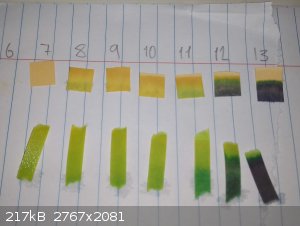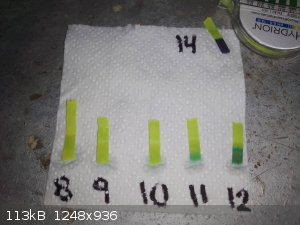VincenzoTheGreat
Harmless

Posts: 2
Registered: 4-3-2019
Member Is Offline
|
|
Calibrating pH papers - sanity check?
Not exactly sure if the title is entirely accurate but basically my problem is that the colour chart for two different sets of pH papers are useless.
The colours for more than a couple of values are near identical but none of the colours appear to match with reality anyway! So I need a way to make
my own colour chart using the papers I have. For now I'm just interested in measuring alkalinity. The "colour chart" was made by making up solutions
for the pH integer values 8-14 and then dipping some pH paper in it and taking a photo of the whole set of values.
I'd like my working out to be sanity checked. Here goes:
I made up a 1.0 M solution of NaOH which by definition is pH 14. The next solution of pH 13 was made by taking a 5 mL aliquot of the former solution
and diluting it to 50 mL by adding 45 mL of water. The concentration in this new solution has now been shifted by an order of magnitude, which accords
with the pH scale.
The next solution of pH 12 was made in the same fashion: a 5 mL aliquot of pH 13 solution was diluted to 50 mL by adding 45 mL of water.
And so on and so forth until I had the whole set of pH values down to 8.
In the photos the ph 6-13 papers are the long strips, and the pH papers that measure 1-14 are the squares (above).


|
|
|
B(a)P
International Hazard
    
Posts: 1114
Registered: 29-9-2019
Member Is Offline
Mood: Festive
|
|
Quote: Originally posted by VincenzoTheGreat  |
I'd like my working out to be sanity checked. Here goes:
I made up a 1.0 M solution of NaOH which by definition is pH 14. The next solution of pH 13 was made by taking a 5 mL aliquot of the former solution
and diluting it to 50 mL by adding 45 mL of water. The concentration in this new solution has now been shifted by an order of magnitude, which accords
with the pH scale.
The next solution of pH 12 was made in the same fashion: a 5 mL aliquot of pH 13 solution was diluted to 50 mL by adding 45 mL of water.
And so on and so forth until I had the whole set of pH values down to 8.
|
Your calculations are correct, but the result you are getting on the papers does not look right. Hold old are they? They do expire and might be past
their prime......
|
|
|
DraconicAcid
International Hazard
    
Posts: 4278
Registered: 1-2-2013
Location: The tiniest college campus ever....
Member Is Offline
Mood: Semi-victorious.
|
|
Diluting a strong base is not a good way to try to get a precise pH. It's likely to contain some carbonate (or absorb carbon dioxide form the air as
you're diluting it). You're better off making some buffers (boric acid/borate, acetic acid/acetate, bicarbonate/carbonate) to get better pH
solutions.
Please remember: "Filtrate" is not a verb.
Write up your lab reports the way your instructor wants them, not the way your ex-instructor wants them.
|
|
|
VincenzoTheGreat
Harmless

Posts: 2
Registered: 4-3-2019
Member Is Offline
|
|
The papers were bought new but who knows how old they are. Two separate brands: Hydrion and Thermo Fischer.
I thought of buying a pen-type pH tester then remembered I have a $500 professional grade electronic meter with calibration standards. smh. Oh, and a
pen-type pH meter (the pool/hydroponic type). That's what I get for having too much chemistry gear I suppose 
@DraconicAcid I agree, NaOH isn't ideal but the stuff I was using was pretty fresh, and even accounting for moisture in the air and decomposition
products I think it's fine in this instance given the margin of error (a whole pH unit). You can see in the pictures at the upper end of the scale
there are definite changes in the paper colour then virtually none at all.
My money is on the papers being shite.
Can anyone recommend a brand they've had consistent results with? And whose colour chart doesn't suck?
|
|
|
Oxy
Hazard to Others
  
Posts: 140
Registered: 1-12-2020
Member Is Offline
|
|
One thing is the actual pH of the solution.
As DraconicAcid mentioned - there might be a lot of carbonates in your base and it can significantly affect the pH. Even if you think it's fresh you
are probably wrong - this is very common to NaOH or KOH to have a lot of carbonates, even from production process. There is a required step which
needs to be done when making standard solution for alkalimetry. Guess what - carbonates removal. Also, the water is likely to contain some carbonates
as well if it was kept in contact with air. It should be boiled to remove the gases.
The other thing is pH paper is not a tool for precise measurement. Good to show if we are below or above of some point but maybe not the best to
distinguish between 13 and 14. There are 4-stripped ones, they could be better.
|
|
|
unionised
International Hazard
    
Posts: 5102
Registered: 1-11-2003
Location: UK
Member Is Offline
Mood: No Mood
|
|
Don't forget the buffering capacity of the dyes themselves.
Things like borax, cream of tartar and sodium sesquicarbonate are reasonable pH buffers
|
|
|
Rainwater
National Hazard
   
Posts: 799
Registered: 22-12-2021
Member Is Offline
Mood: indisposition to activity
|
|
I use these
https://www.homesciencetools.com/search?search_query=ph
I never had an issue as long as i store them in air-tight containers.
Good mom and pop shop.
If you're doing triation, then i would recommend a fixed scale ohm meter and some carbon rods.
Place a sample into a beaker with stiring.
Connect the carbon rods to the meter and insert into the fluid.
I like pencil lead. Cheap and low side effects.
Make sure the probes do not move during the procedure.
Take the ohm reading.
Begin adding your standard solution.
You will see the ohms increase.
When the ohms begin decreasing, you have just passed the netural point.
This method is far more accurate than ph paper or universal indicator and can be done with a $5 meter.
"You can't do that" - challenge accepted
|
|
|